

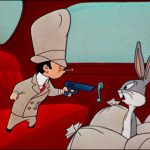
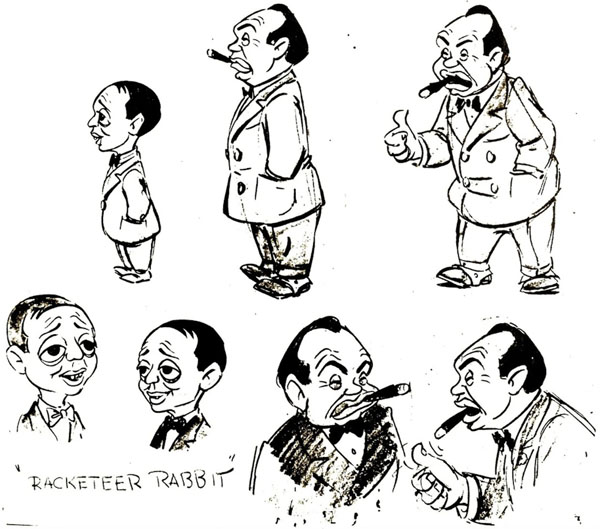
The Warner Bros. Studio has had a long association with “gangster pictures.” WB produced the first one, Little Caesar, in 1930. They made 50 of them the following year. Even the animation department followed the trend. Two cartoon shorts, one made in 1946 and the other in 1954, captured the gangster influence on the Warner output.
The shorts were directed by the same man, Friz Freleng, using slightly different animation teams. The plots, structures, and gags show considerable similarities, yet each brings a distinct flavor to the Warner gangster cartoons. Of course, the most sinister mobsters had no chance against Bugs Bunny.
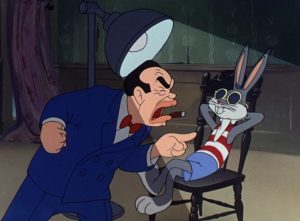 1946 saw one of the finest examples, Racketeer Rabbit. Bugs decides to spend the night in a seemingly abandoned house, but mobsters Rocky and Hugo are speeding his way, shooting it up with cops (they pass a sign advertising the Hotel Friz). Once inside, Rocky and Hugo (caricatures of Edward G. Robinson and Victor Lorre, respectively) continue to blast away. Bugs, nonplussed, gets a drink of water while ducking under Hugo’s stream of machine gun fire (Low bridge!)
1946 saw one of the finest examples, Racketeer Rabbit. Bugs decides to spend the night in a seemingly abandoned house, but mobsters Rocky and Hugo are speeding his way, shooting it up with cops (they pass a sign advertising the Hotel Friz). Once inside, Rocky and Hugo (caricatures of Edward G. Robinson and Victor Lorre, respectively) continue to blast away. Bugs, nonplussed, gets a drink of water while ducking under Hugo’s stream of machine gun fire (Low bridge!)
The mobsters start dividing their haul, but Bugs keeps rapidly popping up as different gang members (with various hats and voices) and collects nearly all the money! This gag is written by Michael Maltese, with smear animation likely by Manny Perez. Rocky gets wise but can’t get the rabbit to talk, so he orders Hugo to take the rabbit “for a ride.” Bugs, now in a motoring outfit, leaves with Hugo, but only Bugs returns.
Bugs asks a sleeping Rocky if he’s forgotten anything, and Rocky says his bedtime prayers, a gun still strapped to his nightgown. Bugs taunts Rocky, who spits out a stream of threats while Bugs dresses him! This scene is one of many highlights featuring Dick Nelson’s voice work; he portrayed the Robinson character in another Looney Tune that same year, Chuck Jones’ Hush My Mouse. Mel Blanc voiced Bugs and Hugo. The Robinson caricature, featuring triple forehead lines, is outstanding; Virgil Ross had done many cartoon celebrities for Warner. Rocky demands the dough, and Bugs makes a cake mixture in ten seconds and tosses it in Rocky’s face. Bug’s quick take before he does that is typical of Ross and reflects Freleng’s great timing.
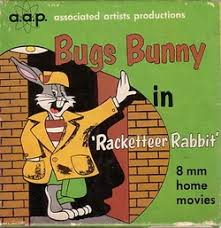 Bugs runs through a door and emerges dressed as a coin-flipping parody of George Raft portraying Bugsy Siegel, terrifying Rocky by telling him, “It’s curtains for you, Rocky.” He then slams a set of curtains over Rocky’s head. As soon as Rocky adores them, Bugs is at the door again, claiming to be the cops. Rocky begs Bugs, who is somehow on the other side of him, to “Hide me!” This line kicks off the old routine common to both this cartoon and Bugs and Thugs.
Bugs runs through a door and emerges dressed as a coin-flipping parody of George Raft portraying Bugsy Siegel, terrifying Rocky by telling him, “It’s curtains for you, Rocky.” He then slams a set of curtains over Rocky’s head. As soon as Rocky adores them, Bugs is at the door again, claiming to be the cops. Rocky begs Bugs, who is somehow on the other side of him, to “Hide me!” This line kicks off the old routine common to both this cartoon and Bugs and Thugs.
Bugs eventually tosses Rocky into a wooden trunk and then pretends to be a modern-day sheriff arguing with himself. The big gag is that Bugs changes in and out of costume, even though there’s no reason for it; Rocky can’t see him anyway! Bugs produces a sword and declares, “Would I do this if my dear old pal Rocky was in there?”, plunging the blade through the chest.
A second sword also goes through the trunk, followed by Bugs/Cop Bugs dragging the trunk violently up and down a staircase. Bugs finally stages a violent fight with himself, at one point really punching himself (appears to be Ken Champin’s animation) before handing Rocky his “watch”, a clock bomb. After it explodes, Rocky flees, begging the cops to take him away. As Bugs Bunny scoffs at him, Bugs’ face morphs into Edward G. Robinson’s. A superb score by Carl Stalling tops things off.
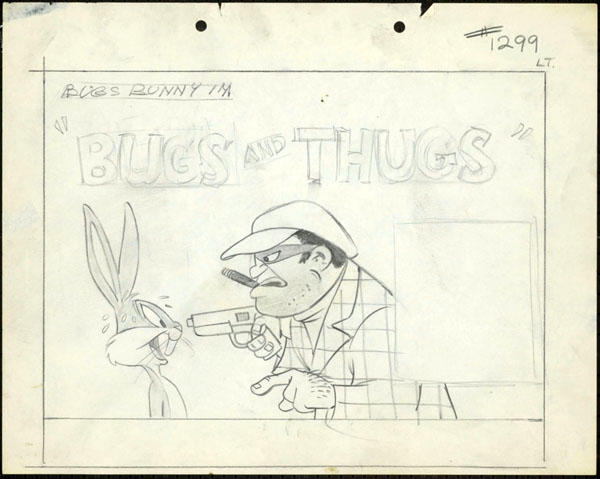
Pencil layout for the promotional lobby card for “Bugs And Thugs”.
From the Academy of Motion Pictures Archive.
Special thanks for this image to Jorge Finkielman
Bugs and Thugs appeared in 1954, with essentially the same director and unit, except that Warren Foster was now the writer, Art Davis was now on the animation crew, and Milt Franklyn composed the music. Rocky and a new lackey, Mugsy, replaced the Robinson and Lorre caricatures. Mugsy may be the work of Gerry Chiniquy, whose simplified design was similar to work he would later do for DePatie-Freleng.
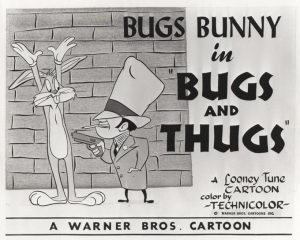 Freleng had long been casting about for more powerful foils for Bugs Bunny, since Elmer Fudd was not particularly threatening. Rocky was a virtual midget, with black hair, a double-breasted suit, a perpetual cigarette, and an oversized fedora that was larger than he was; its brim completely covered his eyes. Mel Blanc provided the voices for both.
Freleng had long been casting about for more powerful foils for Bugs Bunny, since Elmer Fudd was not particularly threatening. Rocky was a virtual midget, with black hair, a double-breasted suit, a perpetual cigarette, and an oversized fedora that was larger than he was; its brim completely covered his eyes. Mel Blanc provided the voices for both.
The cartoon’s opening credits feature police spotlights. Cut to Bugs, heedlessly strolling with a newspaper as he goes to the bank to withdraw carrots (what else?). He stumbles into Rocky and Mugsy’s getaway car. “How much do ya know?” Rocky demands. Bugs rolls off answers like “Carson City is the capital of Nevada”. Rocky tells Mugsy to take Bugs “for a ride”. Bugs is immediately wearing a motoring outfit and starts to chatter. Told to shut up, Bugs continues until told to “Shut up shuttin’ up.”
Bugs asks Hugo to pull over at a nice, clean gas station. He runs to a phone booth and calls the police, but Hugo yanks him out, including the cop on the other end of the line! Bugs then leads Rocky’s car into the path of an oncoming train. Bugs is forced to repair the vehicle and also serve as one of its tires.
Back at the hideout, a silhouetted Rocky gives Mugsy instructions to take Bugs into the other room and “let him have it.” Of course, Bugs ends up with the gun and blasts Mugsy. Rocky, taking things into his own hands, but behind a closed door, Bugs imitates a police car and an Irish cop, Clancy. The “hide me” routine follows, with Bugs stuffing both Rocky and Mugsy into an oven (“I must be dreaming. It couldn’t be this easy!”). Bugs then plays himself and Clancy. Although there are no costume changes, Art Davis does some outstanding smear animation that Rod Scribner might have envied.
What comes next?
Bugs: Would I turn on this gas if my friend Rocky was in there?
As Clancy: Ye might, rabbit, ye might.
Bugs: Well, would I throw a lighted match in there if my friend was in there?
BOOM!!!
As Clancy: Well, alright, rabbit, you’ve convinced me. I’ll look for Rocky in the city.
Just as the cooked cops crawl out of the oven, the REAL police arrive and begin replicating the scene Bugs just played, with the same dialogue right up until the line about the lighted match, at which the crooks beg the cop to arrest them. Warren Foster masterfully built up the gag, and the pacing at which Freleng directed the scene raises it to absolute hilarity.
The short ends with Bugs, now a private eye wearing a Sherlock Holmes-style deerstalker hat, taking calls to advertise his crimefighting skills.
Many fans prefer this cartoon to Racketeer Rabbit, but they are two variations on the same theme, each great in their own way. Which one is your favorite?